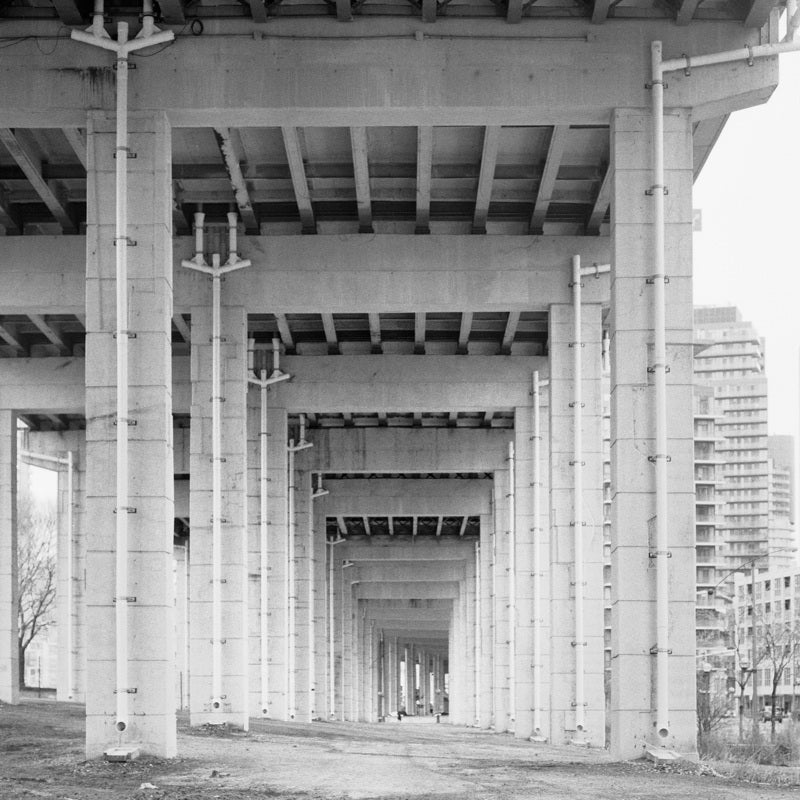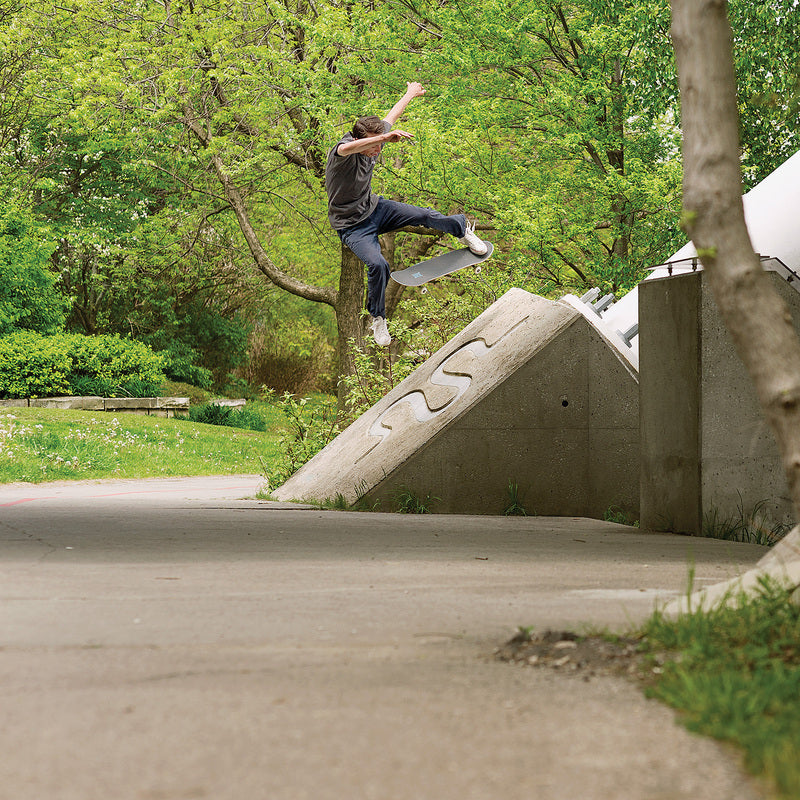Bridge & Tunnel

Bridge & Tunnel
Converse Interprets Architecture
Words and Photos by James Morley
The term ‘bridge and tunnel’, first used in a 1977 edition of the New York Times to distinguish unsophisticated suburban partygoers from a high-class metropolitan crowd in New York City, originally described people who lived outside of the area serviced by the transit system and, as a result, would need to use a bridge or tunnel to travel to the city. While the phrase initially applied to residents of Long Island or New Jersey who would flock to Manhattan to attend weekend parties, it eventually grew to include suburban dwellers from areas further removed from the city. Now, it has broadly adapted to refer to commuters who travel to any large metropolitan region.



As the urban infrastructure that gives ‘bridge and tunnel’ people their moniker facilitates the travel of workers and entertainment-seekers alike, it also allows for countless skateboarders to leave their homes, embarking on a pilgrimage to the cities, urban spaces, and architecture where they thrive. Skateboarding and infrastructure have always had an interesting relationship, whether it was the thirst for new and challenging terrain led the search for fullpipes in Southwestern desert runoff ditches, or the endeavors that created DIY skateparks like Burnside or FDR out of otherwise underutilized space beneath bridges. The Cons Canada team took it upon themselves to investigate the bridges, tunnels, and ditches located around the Greater Toronto Area. By limiting ourselves to spots either located around or formed by these structures, we were able to put together a feature derived from a reassessed and reinterpreted relationship to the infrastructure that connects us.




Over the past century, the role of infrastructure in the urban environment has become remarkably prominent, mainly attributed to the proliferation of the automobile. As cars became increasingly affordable and safe, people were suddenly able to live further from their workplaces, and suburban life with cheap, large property on the edge of rampant urban sprawl, away from the hustle-and-bustle of the city, became both increasingly desirable and feasible. Growing cities began to prioritize their facilitation of the means to meet automotive needs over the small-scale, interpersonal connections and relationships that previously gave cities a certain intrinsic value. This led us to the modern metropolitan area; high-density buildings that lie within a large, cement grid that simultaneously connects and divides everything within its grasp. The single occupancy vehicle dominates the grid, traversing its roadways with little regard for surroundings, ultimately focused on its destination. This grid ‘paved’ the way, so to speak, for capitalism’s manifestation in cities. The modern city projects an illusory veil of life and inclusion, when in reality it acts as a series of checkpoints for the generation and movement of money and other capital. Beautiful, modern buildings and excessive imagery (mainly found in advertising) encourage awe-struck visitors to move through the homogenized mixture of public and “privately owned public spaces,” rather than linger in them, unaware that their willingness to spend or produce money is a critical factor in their acceptance. While people move about urban centers, the cement grid of roads, bridges, tunnels, and ditches acts as a transient space for travel. It is a liminal space for the fleeting presence of most, but the occupancy of none.



Unlike most ‘bridge and tunnel’ people, however, skateboarders thrive on the experience of architecture, consuming it rather than merely passing through. The act of skateboarding itself encompasses a critique of architecture. With every trick you do, you test the materials of the space. You experience and verify the angles at which hard surfaces sit, keenly aware of the forces acting for and against you. Every ripple and crack in the pavement makes a noise that, shortly followed by a vibration through your board and feet, alerts you to fine details of the space, resulting in a hyperawareness of your surroundings and an emotional connection with them. To skateboard means to challenge spatial awareness, and we will occupy any space we can in order to do it.
Modern city centers and their money-oriented goals present a challenge to skateboarders, however, as they not utilize the space with the same intent as most others. Skateboarders disrupt the status quo, moving through space off on an internal map of their experiences with the spaces around them, abandoning the grid that others abide by. Rather than passing through spaces, we occupy them and travel between them based off of our own needs that they could fulfill. While our goal through this appropriation of space is productive, vanilla citizens and property owners view it as an act of destruction. Our unique approach to their spaces unnerves them, as shown by their attempts to dissuade us. The incorporation of defensive architecture in these spaces, such as knobs on ledge, ridges in the ground, or prohibitive placement of planters, lets us know that we are not welcome. This notion can be attributed to a standard city-planning practice where decisions are made based off of the “best use of space.” We do not bring value to these city venues, so the space is not designated for us, no matter how “public” they may be.
Since bridges, tunnels, and ditches are places where people do not tend to linger, they provide a sheltered forum for all sorts of people and activities deemed “undesirable” by city standards. Planners and authorities welcome skateboarders in these spaces. Our presence decreases the likelihood that drug addicts or the homeless will take claim to the space themselves. In these places, we are considered the best use of the space, and we feel right at home in them.



There is a theory that successful and engaging architecture is embodied with a set of values and characteristics that act as a mirror, revealing an idealized version of one’s self. Hectic city centers are filled with tall, simple buildings comprised of abstract compositions of reflective metal and glass, mimicking minimalist art’s calming effects for occupants who tend to experience a higher level of stress within those spaces. Infrastructure often takes on a different set of characteristics entirely. Large volumes of rough cement and exposed metal beams and fasteners embody a raw, weathered aesthetic whose tangible textures, materials, and construction do very little to hide their brute strength. Their tendency towards the abandonment of elegance and beauty reaffirms their intended functional existence, doing little to engage people aside from their moving them from point A to point B. Most of these spaces are free of decoration and resemble a form of functionalism that actually catalyzed modern architecture’s deviation from the classical style that dominated cities for centuries. Now, these infrastructural elements exist visually as relics of the past, ignored and left to deteriorate and collect what seems like a permanent layer of dirt and dust while efforts are focused on the new, pristine spaces in city centers.
Unlike most people, skateboarders do not shy away from this dirt; we embrace it. It adds another element to the rough ground and the sounds of snapping tails, sliding wheels, and passing cars that reverberate along the materials that compose the space, creating a unique sensory experience that you would be hard pressed to find anywhere else. Occupying these spaces is just another step in the same quest for the perfect concrete wave that has led skateboarders to backyard pools, desert pipeline projects, and schoolyard banks for the past fifty years. There is currently a resurgence of skateboarding in cities, defying the spatial norms and acting out against the defensive measure put in place to keep us away. The return to infrastructure, on the other hand, symbolizes a complimentary act of acceptance, acknowledging the challenges that are posed against us and adapting to them. It is a way for us to carve out our own spaces, the same way that we always have.

